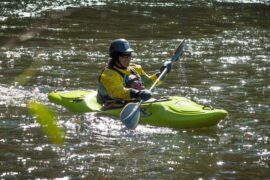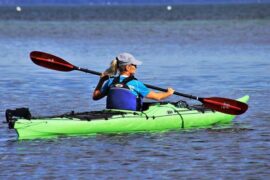Defining a kayak can be quite confusing because of this. There are a lot of names bandied about when it comes to vessels. With terms like watercraft, personal watercraft, paddle craft, boat…. The list seemingly goes on forever. So, can we call a kayak a personal watercraft?
As it turns out, a kayak is not a personal watercraft. This term is reserved for vessels with a primary source of motive power from an inboard motor that powers a jet pump.
Their operators stand, kneel, or sit on them, not in them. On the other hand, kayaks get their power from your paddling, making them paddle craft.
Is a Kayak a PWC?
Kayaks belong to a class of vessels commonly called paddle craft. Paddle craft vessels are more prone to capsizing than other types of vessels.
Kayakers need to assess their experience and the level of difficulty of the waterway before going out on the water.
However, these vessels are not considered to be personal watercraft. This is an entirely different kind of animal when it comes to vessels. But kayaks are still considered watercraft to make things a little more complicated.
Guess what? They’re also considered to be boats. This means that whatever body of water you are in, you must abide by the laws governing boats, including carrying the appropriate life-saving devices required of all boaters.
You will also be subject to any safety inspections being conducted. If there are no vessel zones, you must comply with them like every other boater.
What Is a PWC?
A personal watercraft is typically defined as a vessel with a primary source of motive power from an inboard motor that powers a jet pump. These vessels are designed to be operated by a person who stands, kneels, or sits on them.
Common manufacturers are BRP, Kawasaki, and Yamaha. They do not require any physical power from the rider, such as paddling. All of the propulsion comes from the motor.
Like a kayak, personal watercraft are also considered watercraft because they are vehicles traveling on the water. However, this bit of information might be evident from their name.
While they don’t look like boats, they are considered to be in the same category regarding water laws. So if you take your watercraft out on the lake, make sure you know the boating regulations.
So What Is a Watercraft?
So at this point, you might be a little confused and wonder what the difference is between a personal watercraft and a watercraft. The simple definition of a watercraft is any vehicle used in the water, including submarines, ships, boats, and hovercraft.
Other names for watercraft include waterborne vessels and vessels. Paddle craft and vessels with motors can both be considered watercraft.
What Are the Different Classifications of Watercraft?
To clear things up, we’ll go through the different classifications of watercraft so that you know what each one means with examples.
- Powerboat: This type of vessel can also be called a motorboat or a speedboat. It uses an engine for power. This engine can be either an inboard motor or an outboard motor installed on the back of the boat, containing the internal combustion engine, propeller, and gearbox, in a portable unit.
- Sailboat: This type of vessel is powered using the force of the wind. They are characterized by three different features, including the hull type, keel type, and mast configuration and sails.
- Paddle craft: As mentioned above, this vessel is powered by manual paddling and includes canoes, kayaks, and paddle boards.
- Personal watercraft: As described above, this vessel is powered by an inboard motor that powers a jet pump. Examples include jet skis.
What’s More Dangerous? A Kayak Or a PWC?
There are common dangers associated with both kayaking and using a PWC. Regarding kayaking, there is a real risk of capsizing due to the structure and shape of the vessel. Operator skills and avoidance of bad conditions will help decrease this probability.
Despite using life jackets among kayakers, drowning is still a real risk. Swamping the vessel with rough or choppy waters can also cause an accident.
On the other hand, PWC offers a lot more safety risks. You can also capsize these vessels, and the threat of drowning is still present.
There is a significant risk of damage to your eyes and face because of the rate of speed at which you travel with no face protection.
You can also break bones from the impact with the water or another vessel. The risk of damaging your vessel from collisions or water intake is also a real possibility. The higher rate of speed makes determining where and when to stop harder.
While a PWC is designed to be as safe as possible, a kayak offers excellent safety for its operator. In fact, over recent years, kayak-related accidents have decreased, further establishing their superior protection.
Conclusion
So as you can see, labeling a kayak can get pretty tricky. From being a paddle craft to watercraft to a boat, it can be somewhat confusing what to call your vessel. One thing is for sure; it is not a personal watercraft.
While personal watercraft share similar names with a kayak, such as watercraft, vessels, and boats, they are two completely different things. PWC is self-propelled through a motor, not requiring physical input from the operator like paddling.
The two also have very different safety risks. You’re less likely to suffer broken bones from a kayaking accident, but it’s more familiar with a PWC accident.




